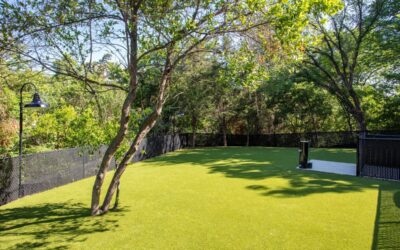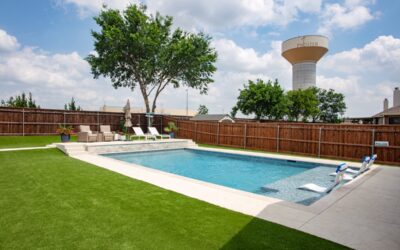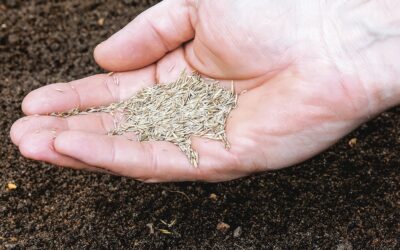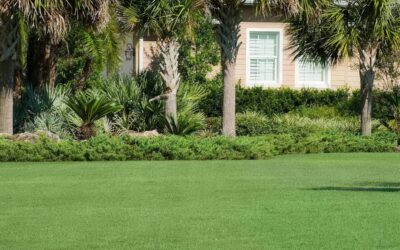Under normal conditions, high-quality artificial turf won’t simply melt in strong sunshine—but certain conditions can cause patches of the turf to melt.
If that happens, you’ll need to take action to correct the source of the melting as well as repair the patch of grass affected to restore it to its fine-looking best.
Fortunately, with some professional help and advice, the problem is easily dealt with and future issues can be avoided.
Below, we describe the types of conditions under which turf can melt, how to prevent it from happening, and how to fix any melted artificial grass areas in your yard…
How can artificial grass melt?
Improvements in turf quality over the years have raised the standards for artificial grass so that it looks pristine for many years without being unduly affected by the climate. All-weather synthetic grass is highly durable and can withstand UV rays, the hottest temperatures, and even freezing conditions without affecting its appearance or performance.
Artificial grass does get hotter than real grass but the good news for home or business owners with artificial grass lawns is that turf will only melt under extreme conditions.
Artificial grass is made from plastics such as polyethylene, polypropylene, and nylon. All such plastics have a melting point above which they will start to disintegrate, degrade or even burn.
At DFW Turf Solutions, the artificial turf is made largely from low-sensity polyethylene (LDPE). This is a flexible polymer that can be stretched or bent without breaking or tearing.
| Plastic Type | Melting Point Range |
LDPE – Low-Density Polyethylene | 180-240 Fahrenheit |
| Polypropylene | 200-290 Fahrenheit |
| Nylon | 190-300 Fahrenheit |
The good news for homeowners is that there’s no climate in the U.S. (or indeed the world) that can produce temperatures hot enough on their own to melt high-quality polyethylene-based artificial turf. The temperature would need to reach 180-200 degrees Fahrenheit—which is impossible for the climate alone to do.
So, artificial grass won’t randomly melt in normal sunshine. However certain conditions can work with sunshine to create temperatures high enough to melt plastic.
At around 175 degrees, artificial turf fibers made of polyethylene will start to change shape and texture.
Under normal conditions, such extreme temperatures are beyond anything experienced in backyards. But artificial grass may start to melt when secondary, reflected sunlight heats the grass or the area is exposed to a naked flame or embers.
Let’s take a closer look at the most common reasons why artificial grass melts…
Reflected sunlight from the home’s windows
Indirect sunlight reflecting off a home’s windows is the single biggest reason for artificial grass melting.
In the south, we have strong sunlight for much of the year. When this reflects off window panes, the sun’s rays may intensify and focus on patches of unprotected grass over a long period, creating hot spots and raising the temperatures significantly in these areas, causing the grass to melt.
This phenomenon is particularly associated with one type of window in homes: Low E windows, which contain glass coated in invisible layers of metallic oxide. This glass allows natural light to enter the home while deflecting UV rays and infrared light back out into the yard. They’re great for energy efficiency but not so great for nearby artificial grass or plants and flowerbeds in sunny conditions.
“Low E” stands for “low emissivity”, in case you were wondering.
How to prevent this problem
When your artificial grass is installed, a professional installation team will check for potential reflection hazards that can raise the temperatures of the grass, especially Low E windows.
If you have this type of window facing your planned artificial grass area, the team may recommend a simple anti-glare, perforated window film or a window screen/awning to shade and protect the area. We can even help with rearranging your landscape to prevent damage to your turf if necessary.
Reflections from other shiny surfaces around the yard
Other surfaces besides windows may also reflect sunlight and produce intense heat on artificial grass areas, causing them to melt.
A few examples include:
- Polished guttering, which is often made in dark colors that readily absorb heat and reflect light from shiny surfaces.
- Mirrors (such as car mirrors) that cause sunlight to reflect at high intensity onto the patch of grass.
- Reflective panels on doors, sheds, outbuildings, etc., which provide a large surface area for light to reflect off.
- Reflections from lawn equipment or other objects left in the yard, which can also channel heat onto artificial grass areas.
How to prevent this problem
A professional installation team will inspect the area around your yard where the artificial grass will be installed.
Over time, when objects are introduced into the yard and you sense that the grass area may be getting hot, you can check the temperature of the grass by laying a thermometer on it where the sun’s glare is concentrated.
Be sure to check the artificial grass at the hottest times of the day. If temperatures start to exceed 150 degrees Fahrenheit, you should think about taking precautionary measures to prevent melting. This could be anti-glare film, non-reflective paint or gutters that reflect the sunlight, for instance.
Direct heat/naked flame
The direct application of heat from a naked flame will burn and melt artificial grass.
You might think that there’s no way you could expose your artificial grass to fire but stray embers from a barbecue or backyard fire pit are enough—especially in windy conditions. They can cause great damage to synthetic turf if you don’t take precautions.
How to prevent this problem
If you have a backyard firepit or barbecue, make sure that it’s placed far enough away from the artificial grass area and that precautions are taken to prevent flying embers from reaching the grass.
Ultimately, having the right team manage your artificial grass installation will protect it from the types of issues that can melt the turf. Then, post-installation, check the temperature of the surface if it is exposed to sun glare. You can even test a small strip of unused grass if you have one, placing it directly in the sun glare and checking whether it shows any signs of melting after a few days.
Should you remove artificial grass from glare spots?
Most times, the intensity of reflections on artificial grass in your front or back yard can be reduced and the resulting temperatures lowered.
If the source of the reflection cannot be controlled with films, screens or other methods to shade the turf area, it may be necessary to re-landscape and move the artificial grass from the path of the sun’s glare.
This doesn’t necessarily mean ripping up the turf installation. Problem spots could be covered with pavers, pebbles or gravel, for instance. Rocks, trees, shrubs, water features or other backyard landscaping ideas could be used to protect the area from sun-melt.
How to fix melted artificial grass
Synthetic grass is often a major investment for homeowners. While there are significant cost savings in the long term, the upfront costs of artificial turf are high and nobody wants their investment compromised by reflections from the sun melting it.
Prevention is better than cure with artificial grass issues but if you do suffer an unexpected turf melting incident, don’t panic. It can usually be fixed with professional assistance.
Call one of our artificial grass professionals for a full assessment of the damaged area, which can usually be replaced.
Some homeowners attempt this as a DIY job. This is possible if you have some experience and the right tools, including seaming tape, a utility knife, a shop vac, and some matching replacement turf.
The steps to fix melted turf are as follows:
- Vacuum up the infill to expose the backing layer.
- Cut the turf: cut through the backing with a sharp utility knife, taking care not to cut the turf fibers.
- Determine the row path of the turf backing: turf backing is woven in rows and your substitute piece’s backing must match the existing turf. The fibers should face the same way as the rest of the lawn.
- Cut a replacement patch: this should be exactly the same size as the removed portion.
- Fit the seaming tape: the seaming tape is placed under the turf opening, covering the entire opening, adhesive side up.
- Press the new turf in place over the tape: the turf should easily stick to the tape but you can also use small tacks/nails to secure it, if necessary.
- Trim the new fibers if necessary: fill in the spaces between the fibers with a uniform layer of infill.
The new piece of grass may not precisely match the color of the rest of the grass but any differences will become less visible over time.
How else can artificial grass degrade?
The best artificial grass will stand up to everything the weather throws at it—including the hot sun—if installed properly. It should also hold its color even in intense sunlight.
However, synthetic turf is not indestructible. As well as window glare or embers from fires causing melting or burning, the degradation of artificial turf may also be accelerated by neglected maintenance.
Turf is much lower maintenance than real grass but it does need a little care and attention from time to time to keep it looking pristine and performing as you expect.
You should also take steps to prevent certain chemicals, gasoline, oil, fertilizers/pesticides, paint, antifreeze, and strong cleaning agents that may be used around your home or yard. from leaking directly onto your artificial grass surface, as this could degrade the area too.
Fix and prevent melted artificial turf
Synthetic grass is understandably popular because it looks immaculate with next-to-no maintenance (no watering, weed killers or mowing) and provides cost-saving benefits over real grass.
But melting of artificial turf can be a problem if you don’t take the types of preventative measures outlined above.
If you have a melted patch of turf, get professional assistance to fix it. Talk to an artificial grass professional at DFW Turf Solutions to discuss your turf options.






